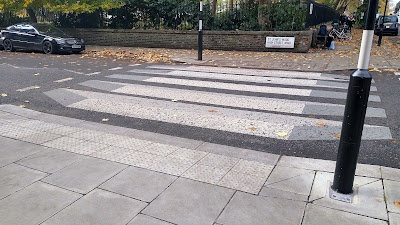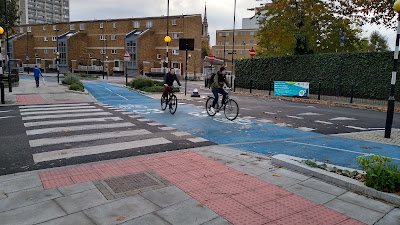This week, I headed out on my bike again on a longer ride to blow the cobwebs today and as is often the case, I go out with a destination in mind. This time, I had a couple of zebra crossings I wanted to have a look at.
First is over in St John's Wood High Street in the City of Westminster, just to the west of Regent's Park. The reason I wanted to look at the zebra crossing here is because Westminster City Council decided that we need zebra crossings which look like stepping stones, thus copying others which have been installed in other countries.
Here is the crossing just south of the junction with Wellington Place (above), which was installed in early 2019. As you can see, the white stripes of the crossing have grey blocks around them to create the effect - except at that distance, about 15 metres, the effect doesn't quite work. No, you need to be right on it to actually see it.
The photograph above was taken at about 5 metres from the crossing which is where one can see the effect which is, more or less, a series of 5 coloured blocks which kind of look like they are in the carriageway and you have to be in the centre of the carriageway to see it! From a pedestrian point of view (below), there are no boxes, just stripes which don't quite look right.
So why was the crossing done this way? As best as I can work out, the crossing itself was installed to allay a local resident/ school safety concern and Westminster City Council said;
"said the design had "been proven" to make roads safer, with one similar crossing in New Delhi, India, leading to average speeds dropping from 31mph (50kph) to 19mph (30kph)."
Cllr Tim Mitchell, the local cabinet member was reported as saying;
“Our 3D zebra crossing could be the future of road safety across the country and once again Westminster City Council is at the forefront in innovation in bringing this type of crossing to the UK.
“Far from being simply a brilliant innovation that makes the ordinary look eye-grabbing and modern – the 3D effect helps drivers to see the crossing easier.”
The claims about New Delhi have been reported locally as having come from the local police, but in a more detailed news report, the claims are a little different. Speeds from people driving smaller cars reduced by a minimum of 1.6% whereas HGV drivers slowed by a maximum of 20.3% because they sit higher up where the effect is more obvious. I have had a search and I haven't found any academic or official paper behind the claims, but of course I would be interested to read anything.
The St. John's Wood crossing was apparently a 12-month trial, but I can't find anything published by the Westminster which has added another two of the same type. What can't be ascertained is if the 3D effect is impacting on driver speeds because as a new installation, there is no base data with a standard crossing. In any case, the road markings associated with zebra crossings are prescribed and this 3D effect could be argued as unlawful.
The other problem with the crossing is the tactile paving. Zebra crossings should have red blisters in an 'L' shape. Here we have light grey without the stem of the 'L' which is how some visually impaired users orientate themselves. With the footway being light grey, the tactile paving doesn't show up well. The crossing is in a conservation area which does have a relaxation on colour in the guidance, but the tactile paving should at least provide a contrast to the paving.
Here's a quick video of the crossing;
Frankly, it's a gimmick which doesn't seem to have much science behind it. If you want people to drive more slowly over a zebra crossing, then build it on a road hump.
The other zebra crossing I had a look at is 8.3 kilometres to the southeast at the edge of Whitechapel at the junction of Cable Street and Sutton Street on London's C3 Cycleway (formerly CS3). C3 is a 2-way cycle track which runs on the northern side of this section of Cable Street. In fact, the layout predates CS3 as you can see on Google Streetview in June 2008;
As you can see above, cycle traffic had to give way everywhere and the urban realm is bleak and pinned in by guardrail. Under Johnson's Mayoralty, the existing cycle route was painted blue and some layouts were tweaked including this junction as you can see on Google Streetview in August 2014 where the layout is simplified, the cycle track is placed on a road hump, but cycle traffic still gives way;
Changes to the junction were proposed in early 2018 and by the Autumn of 2020, priority was given to people walking and cycling across Sutton Street. As you can see in the photograph below, C3 now has a parallel zebra crossing over Sutton Street and it is drivers who now give way as they turn right into and left out of Sutton Street.
Both the cycle and pedestrian parts of the crossing are nice and wide with the geometry for drivers being nice and tight.
As has become the fashion, the space used to set turning drivers off the crossing is filled with some incidental rain gardens to give a completely transport little bit of urban realm. Personally, I don't like the blue surface colour, but the scheme matches what was there before. I prefer the gentle red of Old Bethnal Green Road elsewhere in Tower Hamlets.
The other thing I would change is the kerbs running across the cycleway. This section of C3 has quite a lot of them and many have failed. The transition between a cycle track and a carriageway should be asphalt to asphalt. That aside, it is so much better and is the standard that this type of junction should be.
I'll leave you this week with a little video of this crossing;









That 12 month trial in St John's Wood is still there.
ReplyDeleteSurprised?
Hah, not at all. This was a political folly in my view!
Delete